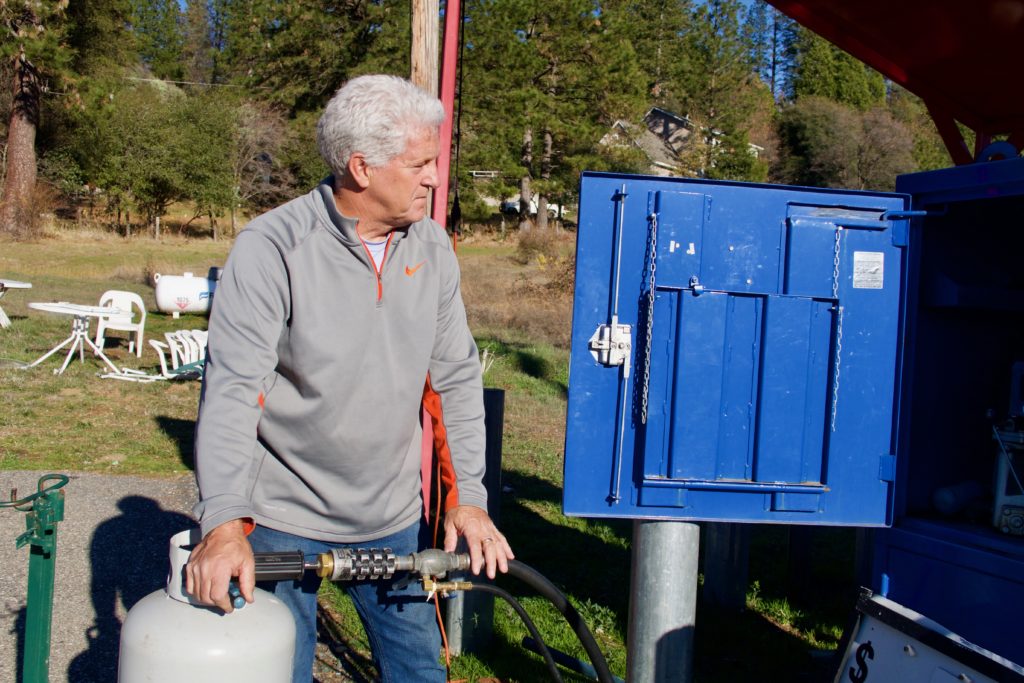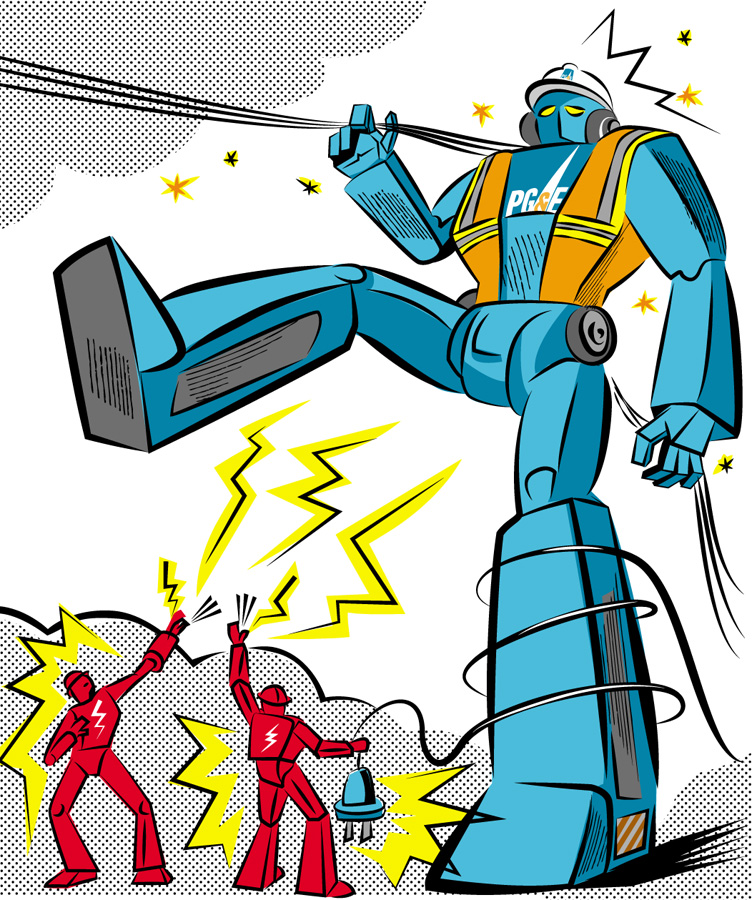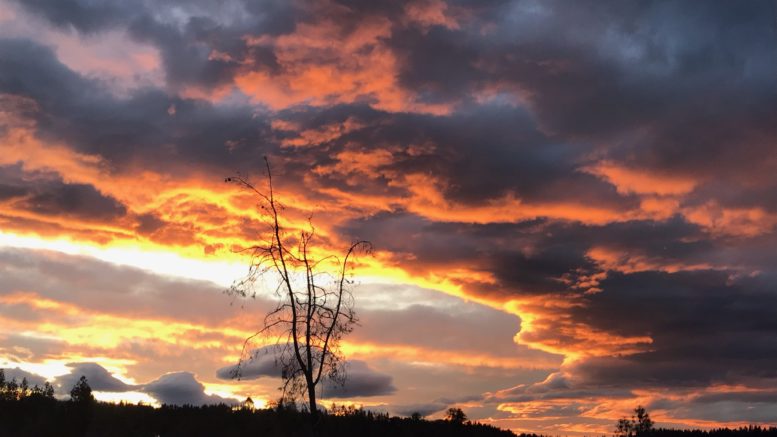Small governments make their stand against PG&E
By Scott Thomas Anderson
The last light of the year is rising as trucks exit the gates of Nevada Irrigation District, turning toward a sharp, lavender lining ablaze under the morning’s flatiron clouds. The vehicles roll through a dim neighborhood of sleepy houses until they reach West Main Street of Grass Valley and crest a hill overlooking its patchwork of Victorian and Art Deco buildings. Within seconds, they’re descending through a ramshackle corridor of Gold Rush survivors that mark the city once called “the Quartz Queen of the West.”
Just like every morning, these NID technicians are making their way by rows of standing history—the shadowed balcony of the Holbrooke Hotel, where Mark Twain stayed when he captivated Grass Valley with one of his early comedy showcases; the crimson, light-studded bricks of the Alpha Building, where a European countess with a pet grizzly bear once titillated miners while performing her famous “spider dance;” and a bend of buildings once called “the Waterfront” for the number of whiskey-soaked saloons.
Today’s Grass Valley is a working-class mosaic of ranchers, farmers, merchants and artists of every background. Unlike the many frontier towns that later returned to dust, Grass Valley’s longevity was ensured when its scattershot of gold sluicing camps was swept away by a trio of powerful mining monopolies. Big investors brought lasting infrastructure, rooted families and generations of job security.
But lately residents fear a different monopoly is dooming their way of life—and they’re thinking about doing something about it.
Last fall, the city, along with surrounding communities in Nevada County, experienced four widespread, extended blackouts over the course of five weeks. Each event was triggered by PG&E’s new Public Safety Power Shutoff program, which the utility created in the midst of being sued for causing catastrophic loss of life and property in wildfires in 2017 and 2018.
PG&E’s records indicate that few regions were hit harder by its safety outages than Nevada County. One area that that did fare worse included the towns of Paradise, Magalia, Concow and Yankee Hill, where people are still recovering from the 2018 Camp Fire; PG&E severed them from power seven times between June 8 and Nov. 21.
In Nevada County, PG&E was planning a fifth shutoff just days before Thanksgiving, only calling it off hours before when an unexpected rainstorm arrived.
For Grass Valley, the blackouts shuttered small businesses for days, leaving owners without revenue and employees with diminished paychecks. Thousands of residents also lost water, while even more saw their internet and cell phone coverage evaporate. This communication collapse only made things worse as people scrambled to take care of isolated seniors and the sick and disabled who rely on power for their medical equipment. Some schools in the county reportedly lost nine days of class time.
When PG&E CEO Bill Johnson told the California Public Utilities Commission on Oct. 18 that places like Grass Valley can expect ongoing power shutoffs for at least the next 10 years, residents and business owners alike began wondering if their community—indeed if any rural community under PG&E’s dominion—can really sustain itself.
So, many in Grass Valley are turning their hopes to the men and women of Nevada Irrigation District—and those big white utility trucks that roll through the city each morning. The district has a plan that could allow Nevada County wrestle control of its power grid from PG&E.
At the same time, leaders in Butte and Yolo counties are joining a larger movement to use political muscle to force a public takeover of PG&E altogether.
David and Goliath

Jeff Rutherford drops a small propane tank onto a tree stump and fixes a nozzle to it as the day’s long winter shadow falls. Two men wearing flannels stand between Rutherford and their pickup trucks, holding more chipped and faded propane tanks to be filled.
It’s Rutherford turn to man the Rainbow Market, the small grocery store he owns on the far outskirts of Nevada City. The place is a lifeline for those who live in this back country of quiet ridges and alpine meadows. There’s nothing out this way but his market and the Willow, a western-style saloon that cooks steaks on an indoor fire pit between its time-worn bar and rustic dining room. Together, the Rainbow and the Willow mark a last stop on this north stretch of Highway 49 before the upper foothills give way to the isolation of the High Sierra.
Both businesses went dark during the blackouts.
“All our perishables went bad, and I had to throw them out, and then buy them again, and then throw them out again,” Rutherford recalls. “I didn’t really think [PG&E] would do it. I thought there were just too many people who’d be affected, too much life disruption.”
Even when Rutherford finally got his market operating in a bare-bones manner by generator, he couldn’t use its popular propane-filling station, which is hard-wired to the power grid. That was not just a sales loss for him, it was a major frustration for his customers, many of whom were trying to keep their own propane-fueled generators running.
“There was a huge demand for propane, not just for generators that were down, but for those whose heaters were down and were trying to use makeshift propane heat,” Rutherford says. “It just seems like everybody I talked to got hurt. I can’t think of anybody I know that didn’t suffer financial loss.”

The numbers back Rutherford up. During the most widespread blackout in early October, virtually all of Nevada County went dark for nearly five days. The Grass Valley Downtown Association and Nevada City Chamber of Commerce conducted a joint economic impact survey with local businesses. While only a fraction of them responded—69 between the two cities—the results were jarring. Those businesses estimated they collectively lost $1.3 million just between Oct. 9 and 12.
“There were concerns with a lot of the business owners about revenue that wasn’t made, and that they might not be able to pay their employees what they were planning for—employees who were then going to have trouble paying their own rent and bills,” says Marni Marshall, executive director of the Grass Valley Downtown Association. “It’s this huge trickle effect … A lot of business here operate month by month, just like a lot of people who work here are living paycheck to paycheck. We knew this could be a tipping point for some people.”
Even PG&E’s planned November blackout that was canceled for Nevada County had an impact, delaying travel plans and tourism in the area, a cornerstone to the local economy.
Marshall says that when business owners eventually gathered together to lick their wounds, news that Nevada Irrigation District might be able to help caught everyone’s attention.
The publicly owned district was formed in Grass Valley in 1921, when the city’s Empire Mine was still in its gold-producing prime. The special district provides municipal, residential and agricultural water across 287,000 acres in Nevada and Placer counties and also produces clean, hydroelectric energy from power plants that it owns on local waterways, enough energy to power some 60,000 homes.
On Nov. 6, about a week after the last blackout that crippled its customers, the district’s board of directors told staff to explore whether it could manage a takeover—or “take-back,” as some locals say—of the region’s entire power grid. District managers were directed to negotiate with PG&E for the purchase of its assets and operations in the North Gold Country before the corporate giant met its bankruptcy court deadline on Nov. 20.
On Dec. 11, Assistant General Manager Greg Jones showed the board a plan that involves providing energy to some 87,000 customers in Nevada and Placer counties. The proposal—which has an initial $300 million price tag and calls for $550 million in revenue bonds—would also result in local ratepayers receiving smaller bills than they currently have under PG&E, while flowing as much as $150 million annually into the local economy.
More importantly, Jones says the district would have the technology for smaller, more targeted power-shut-offs during red flag warnings for wildfires. In theory, the days of virtually every business and house in Nevada County being dark due to wind would be over.
But by the time Jones was making his presentation, PG&E had announced it had a plan to re-emerge from bankruptcy. Rather than requesting the Nevada County Local Agency Formation Commission to study their plan, the board voted to delay any action until it had more knowledge of how PG&E’s bankruptcy story would end. The board also wanted more data on how the district would handle its own liability risk from fires.
Two days later, on Dec. 13, Gov. Gavin Newsom announced he was rejecting PG&E bankruptcy plan, calling it a lackluster attempt to reform the failing and controversial utility. Even with more uncertainty on the bankruptcy case, Jones says the district remains interested in moving forward.
“Our notice of intent to purchase PG&E’s assets is still on the table,” he says. “It’s still valid and we’re not rescinding it.”
Emphasizing the district’s relationship with the community, Jones adds, “We’re a public entity that’s right here. If a customer has any issue with their service, they’re able to walk right into our board meeting in Grass Valley and raise their hand up.”
Elected officials in Placer County’s suburban cities of Rocklin and Lincoln have also began exploring whether they can cut the cord from PG&E for good in favor of a local alternative.
Residents and business owners in those areas are waiting to see if they’ll have that ability when the most intense wildfire threat returns in summer and fall. Marshall points out the collective dread around the outages in Nevada County is still fresh in everyone’s minds.
“This was an eye-opener for everyone, really, in terms of realizing how fragile we are,” she says. “When you don’t have electricity, running water or communication, things can start getting squirrely really fast. There’s a lot of things that can go wrong here.”
Darkness in the scar

Ria Abernathy walks from the door of her RV onto the open ground of Magalia’s relief center, passing by the looming, charred grey-and-red spur of Sawmill Peak. She crosses by a wide emergency tent recently brought down by snowfall, then stops at the modest memorial that looks out on sweeping views of bald, still-blackened hilltops to the south.
This understated monument was built entirely with bricks from houses that burned in the Camp Fire. Abernathy is looking down at a brick from her own house that went to ashes. It bears the address she once lived at in Paradise, 6265 Fern, and it also has her name and the name of her teenage grandson who lives with her in the 24-foot camper. Abernathy breathes in the cold afternoon and glances a bronze plaque lined with names of those who were lost to the flames.
“We know it’s more than that,” she mutters. “Everyone who lives around here knows there were homeless living out in the woods who will never be accounted for.”
Abernathy is among families and individuals living in 17 RVs on the grounds of Magalia Community Church. For the last day they’ve all been listening to news about the wildfires in Australia, contemplating the images of people running for their lives, of animals burning in droves, of endless skies the color of a Biblical nightmare. For the displaced refugees of this little makeshift community, the news is triggering tearful memories of watching their own world burn 14 months ago.
Yet as difficult as this week has been—as hard as this winter has been—for Magalia, the storms and frigid temperatures have at least brought an end to the town’s relief center having its power cut by PG&E. Residents of this remote stretch of woods say the outages don’t just cause what people think of as a normal nighttime darkness. Rather, they say, the blackest kind of sheer blindness descends over the fire-scarred ridge. Abernathy had just moved into the camper at the relief center in early October when the safety shutoffs started. She watched the center’s workers and volunteers scramble to try to save thousands of dollars in frozen meat.
“I was frustrated, stressed out and just in disbelief,” Abernathy says. “If you went through what we went through, you’re thinking, ’Why are you doing this now, instead of when it could have made a difference?’ It’s just another slap in the face.”
Doreen Fogle, a volunteer at the relief center, said PG&E shut-offs forced her operation to close for five days that it would have been open in September and October.
“That means all of the people who come here for food, which is 200 to 300 on any given day we’re open, weren’t able to get the necessities they needed to sustain themselves,” says Fogle.
Like many rural areas in California, Butte County doesn’t have a local agency like Nevada Irrigation District that could take control of its power grid. While its leaders recently formed the Butte Choice Energy Authority, an effort to give the region control of energy purchases, the grid’s infrastructure will remain in the hands of PG&E.

That’s one reason Chico Mayor Randall Stone recently signed a letter, which was sent to the California Public Utilities Commission on behalf of more than 50 elected officials. Citing PG&E’s repeated safety and service failures, the letter urges a complete public takeover. Stone says a few of Chico’s newer housing developments were repeatedly hit by the blackouts, along with neighborhoods in nearby unincorporated areas, while PG&E vaguely suggested the city’s downtown might go dark.
“You’re looking at the volatility that’s injected into the community whenever there’s a proposal to shut off power, just from the anxiety it causes alone,” Stone says. “This is a community that’s already suffering terribly from the kind of chaos that PG&E’s infrastructure causes. The outages just make that pain even more acute.”
Stone, a longtime financial planner, also says he signed the letter with his fellow mayors and county supervisors for a practical reason.
“I think it’s necessary for PG&E to be publicly owned from a financial perspective alone,” he said. “It’s going to cost 50 to 60 billion to bring PG&E’s infrastructure up to safe standards. That is an extraordinary amount of money. I just don’t see how it’s possible to do it unless the utility is customer-owned … I think the Legislature is eventually going to come to the conclusion that it has to go this way.”
Yolo County Supervisor Don Saylor agrees and signed on to the letter. While his constituents are largely supplied by Valley Clean Energy, all of their power runs through PG&E’s transmission lines and infrastructure and is thus subject to the blackouts. Last June, the small city of Winters in Yolo was the first area to be hit by an intentional PG&E shutoff in 2019. Records indicate that Winters has been covered by every single shutoff since.
“We’ve been concerned about the captive market for some time,” Saylor says of PG&E. “When we see dividends paid year-after-year to stockholders, and massive bonuses given to executives, it creates uneasiness because they’re not making the right investments in the infrastructure, and they’re not bringing lines underground. We think the money has been misspent and mismanaged, and there probably needs to be a fundamental restructuring.”
For Davis Mayor Brett Lee, signing onto the letter urging a public takeover was imperative for the future of the state’s economy. Though Davis has largely been spared from the blackouts, Lee says Northern California can’t remain a leading hub of innovation with the world constantly seeing news stories about power being shut off from the Silicon Valley to the suburbs of the state capital.
“We’re supposed to be the high-tech capital of the world, and, there’s no electricity for a week?” Lee asks.
Lee also believes that PG&E’s long history of negligence—it’s already under federal criminal probation for the 2010 San Bruno gas pipeline explosion that killed eight people—means Californians simply can’t have confidence in it.
“Not every public entity is transparent, or works in the best interest of the community they serve, but more often than not, compared to a private entity, they respond to the public more,” Lee says. “In our own backyard we have Sacramento Municipal Utility District, and there’s no weird scandals with them … PG&E is accountable to their investors, by law. That’s their master.”
As PG&E’s bankruptcy case hangs in legal limbo, leaders including Lee, Saylor and Stone are waiting to see if the governor and CPUC will finally start moving toward ending corporate ownership. Yet at Magalia’s relief center, many survivors find the idea of PG&E facing a true reckoning difficult to imagine. They also have more immediate concerns. Many are still living in cars and tents. There are still few jobs. Most locals have seen their friend or family networks vanish, lost to death or displacement.
Abernathy was just assigned a disaster case manager after waiting for more than a year, but says it’s not clear what that person can really provide.
“And we keep seeing more of the trees finally dying,” she reflects, pointing out to the seared, half-lunar landscape spanning the ridge. “A lot of us loved living out here because we were surrounded by the trees. With every day, you see another tree die, and another little piece of yourself dies with it.”




Be the first to comment on "Taking back the power"